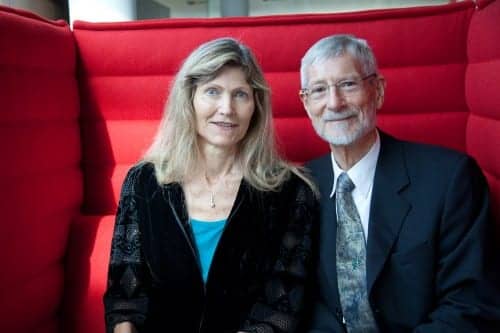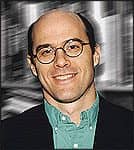The National Academy of Engineering (NAE) has announced that bioengineering pioneers and MED-EL co-founders Ingeborg Hochmair, PhD, and Professor Erwin Hochmair have been awarded the 2015 Fritz J. and Dolores H. Russ Prize for helping engineer cochlear implants. Ingeborg is the CEO of hearing implant manufacturer MED-EL. According to the announcement, the prize is shared with Duke University Professor Blake Wilson, a MED-EL advisor and director of MED-EL’s first US-based, onsite basic research laboratory in Durham, NC; Professor Graeme Clark, University of Melbourne; and Professor Emeritus Michael Merzenich, University of California, San Francisco. The Russ Prize will be presented at a gala reception at the National Academy of Sciences in Washington, DC, on February 24, 2015.
The Hochmairs and their co-recipients are being recognized for their outstanding bioengineering achievements in the development of cochlear implants. The cochlear implant was, says the announcement, the first device that replaced a human sense: the sense of hearing. The lives of nearly 450,000 people of all ages around the world have been touched because of the vision and pioneering work of many researchers, engineers, and surgeons.
“Our corporate mission is now the same as our personal mission from the start: to overcome hearing loss as a barrier to communication and quality of life,” said Ingeborg Hochmair. “While it was possible to develop the very first multichannel cochlear implant system as a very small engineering team, our current development team is comprised of approximately 250 engineers and physicists, all working passionately towards future technological advances for existing and new recipients of hearing implant systems.”
“Designing and further developing hearing implants has been so intriguing because it involves many different fields of science and engineering such as circuit design, microelectronics, radio frequency engineering, mechanical engineering, material science, information technology, software development, and acoustics, in addition to the physiological complexities associated with working with the human body,” said Erwin Hochmair. “But, it is so much more than an engineering task. Opening the world of sound to people living in silence is an idea that would have once been ridiculous. It’s humbling to think of the many infants, children and adults from around the world who have had doors opened because of this technology – an idea whose time had come.”
The Multi-channel Cochlear Implant Makes History
According to MED-EL, cochlear implant development was initiated in 1976 by Ingeborg Hochmair, a PhD in electrical engineering, and Erwin, a Professor at the Technical University in Vienna, at the request of Professor Kurt Burian, head of the ENT-Clinic at the University of Vienna. The implant had 8 channels, a stimulation rate of 10,000 pulses per second per channel, 8 independent current sources, and a flexible electrode for 22-25mm insertion into the cochlea. This led to the world’s first multichannel, micro-electronic cochlear implant surgery in Vienna, Austria, on December 16, 1977. Professor Kurt Burian performed the early implant surgeries.
Research and development continued over the next several years with pioneering deaf patients. With a modified version of the original device, the next milestone in cochlear implant development was reached in 1979: the understanding of words and sentences without lip-reading in a quiet environment via a small, body-worn sound processor. The size of the processors and internal settings were refined over the years. By 1985, results from implanted post-lingually deaf adults showed that 60% had some sound-only speech understanding without lip reading.
In 1990, the Hochmairs founded MED-EL and hired their first employees. In 1994, the implant system COMBI 40 was launched. It was the world’s first multichannel high-rate cochlear implant designed specifically to implement Blake Wilson’s groundbreaking Continuous Interleaved Sampling (CIS) sound coding strategy with high stimulation rate. Dr Wilson’s CIS discovery and development have dramatically altered the way that sound is processed through cochlear implant technology. CIS remains the gold standard for cochlear implant audio processing systems. To date, most of the newest processing strategies are either CIS or advances based on CIS.
MED-EL Founders and Collaborators Look Toward the Future
Today, MED-EL continues to develop hearing implant technology. Ingeborg leads the company as its CEO, and the Hochmairs and Dr Wilson continue to collaborate on new research. The early cochlear implant discoveries led to the development of new technologies to treat hearing loss, including electric-acoustic stimulation and auditory brain stem implants. While once limited in scope, the adoption of cochlear implants continues to expand around the world. However, there remains a great need for improved access to this technology, which has the potential to improve the lives of many millions of people globally.
“How fitting that the Russ Prize is granted to innovators who plan for the future,” said Raymond Gamble, president and CEO of MED-EL North America. “Since its inception, MED-EL has created technology with both recipients and the future in mind. MED-EL’s cochlear implants and audio processors have always been designed to allow recipients to access the latest programming software, even with earlier-generation implants. In addition to the Hochmairs’ engineering achievements, which are impressive in their own right, [MED-EL’s] culture of lifetime commitment to our recipients truly deserves honoring and recognition. On behalf of MED-EL’s North American employees, we congratulate the Hochmairs, Dr Wilson and all of the 2015 Russ Prize winners for this outstanding award.”
Speaking to future bioengineers and researchers, Ingeborg said, “We live during one of the most exciting times in history for biomedical research and development. The outgrowth of technological advances has been exceptional in terms of the possibilities for people with hearing loss and many other medical conditions. What seemed impossible just a generation ago, is now not only possible, but has become widespread practice. There are so many further developments awaiting realization and many discoveries yet to be made.”
The Russ Prize Recognizes Outstanding Bioengineering Achievements
Awarded biennially, the Russ Prize recognizes an outstanding bioengineering achievement in widespread use that improves the human condition. This achievement should help the public better understand and appreciate the contributions of engineers to our health, well-being and quality of life. An auxiliary purpose of the Russ Prize is to encourage collaboration between the engineering, medical, and biological professions.
It is worth noting that there is no Nobel Prize for engineering, but Ingeborg Hochmair was a co-recipient of a Lasker Award in 2013, considered by many to be the “American Nobel Prize,” for her contributions in the development of the cochlear implant.
For more information about the Russ Prize, visit the NAE website.
Source: MED-EL and NAE





